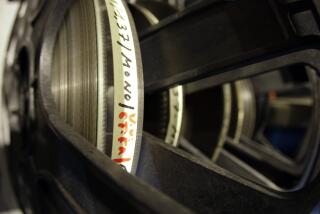Picture Palaces in Freeze Frame
- Share via
Gregory Lukow is the assistant chief of the Library of Congress’ Motion Picture, Broadcasting and Recorded Sound Division. When he’s not busy preserving cinema history for the nation’s library, he travels the country taking photographs of old movie theaters.
“The Last Picture Show,” a melancholy and nostalgic photo journey featuring 45 of Lukow’s photographs, will be on display at the Hollywood Entertainment Museum, Friday through May 29.
Among the theaters depicted in his photographs are the Rex Theater in Hayden, Ariz., an old drive-in in Dove Creek, Colo., and the El Capitan Theater in San Francisco.
Until January, Lukow worked at the American Film Institute in Los Angeles, where he supervised the restoration of such films as the 1912 “Richard III” and the all-digital restoration of the long-lost first episode of the “Our Gang” comedies that was produced in 1922.
Lukow talked about his photographs and the exhibit recently by phone from his office at the Library of Congress in Washington.
Question: Did you have any favorite movie theaters growing up?
Answer: I have two. I was raised on a farm in Nebraska and the nearest town was Hastings, 20 miles away from our farm. Hastings had two cinemas downtown--the Strand and the Rivoli. The Strand is now an office building and the Rivoli was closed for over a decade, throughout the ‘80s, after a mall cinema got put in at the edge of town. But the mall cinema kind of died in the ‘90s and the Rivoli has made a comeback.
Q: Why did you start taking pictures of these movie theaters?
A: I started in 1988. I took the first vacation I had in years. I took three weeks to drive around the American Southwest on my own. I had bought a camera [before the vacation] and it was clear once I got started that I had a budding and photographic obsession. It was something I had to do and I have been doing it ever since.
Q: You have taken pictures of 2,000 theaters?
A: I was actually recalculating that. It’s over 9,000 photographs documenting over 2,000 theaters, which tells you that I take more than one photo of each theater.
Q: Have you visited every state?
A: I have never been to North Dakota or Maine. There are some other places I have never been. I have driven just about every back road between California and Nebraska you can find. In fact, I have even driven from Los Angeles to Nebraska by way of Montana. That tells you how far I am willing to go out of my way to find roads and small towns that I have never seen before.
Most of my photography on the East Coast has been from taking time on business trips or flying into cities and taking time to drive around. But now that I am living in Washington, one of my true delights of anticipation is trying to find a myriad of new ways to drive between the East Coast and the Midwest.
Q: Do you shoot primarily in black-and-white or in color?
A: All color. It’s part of what I am looking for. Sometimes it’s a very new and vibrant color showing the life of the place, and sometimes it is a very decayed, abandoned coloration, which is also part of the death of the theater.
Q: Have you noticed in your travels that some of these vintage theaters are making a comeback?
A: I have seen it go both ways. I have driven through small towns and photographed a theater one year and come back [in a few years] and it is gone. I have a photo of the theater called the Chief Drive-In in Grand Junction, Colo. I came back a couple of years ago and it was occupied by the parking lot for a Wal-Mart.
And I have seen the other side. I have seen theaters that have been sitting for years and you come back and suddenly they are part of a small town’s strategy to revive the downtown Main Street core.
College towns are another place where older downtown theaters tend to be preserved because those college-age audiences can keep them alive. I went to school at the University of Nebraska at Lincoln and there were a couple of them that survived. The Stuart is still going strong.
Q: Would you discuss some of the photographs that are included in the exhibit and why you picked them?
A: I picked all of them from the earlier years of my photography. All of these were [shot] between 1988 and 1994. One of my favorites is the Rex Theater in Hayden, Ariz. It is an abandoned theater located in a little mining town in southeast Arizona--a place you’ll never go to. The theater is in what used to be the downtown area and which is a now a virtual ghost town. The theater is right across from the local union hall for the miners. Someone had written in very large painted letters [on the theater], “Union Yes! Forever!” I liked the photo because I caught it at dusk on a day with very dramatic lighting.
Q: Do you have many photographs of theaters in Los Angeles and surrounding areas?
A: I have quite a few. The Jet Drive-In between Lancaster and Palmdale is just west of the old Sierra Highway. It was just basically a kind of a lonely little sign standing on a tall, thin pole along the side of the street surrounded by concrete desert. That is all that is left of it. [The pole] is so thin and frail--a reminder of what used to be there. It captured for me a certain kind of sadness in that area.
*
* “The Last Picture Show” can be seen Thursdays to Tuesdays from 11 a.m.-6 p.m. at the Hollywood Entertainment Museum, 7201 Hollywood Blvd. Admission is $7.50 for adults; $4.50 for seniors and students; $4 for kids 5-12 and free to museum members and children under 5. Call (323) 960-4833.
More to Read
Sign up for The Wild
We’ll help you find the best places to hike, bike and run, as well as the perfect silent spots for meditation and yoga.
You may occasionally receive promotional content from the Los Angeles Times.







